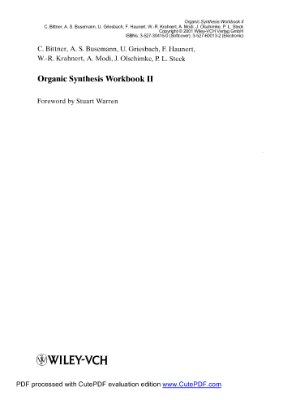Wiley-VCH Verlag GmbH. D-69469 Weinheim, 2001. - 291 p.
Organic Synthesis Workbook II will be the answer to many young organic chemists prayers. It is a set of problems of extraordinary diversity set within the framework of large syntheses. This gives the young authors (all members of Professor Lutz Tietze's research group at Gottingen) the freedom to reveal details or to conceal them. The reader might be asked simply to fuish a reagent for a given step, or more challenging questions like explaining a mechanism or a stereoselectivity. Even prediction appears as some of the intermediates in the big syntheses are blank spaces to be filled in. The layout is intriguing - one wants to read on, as in the best novels, first to find out what happens and then to find out how it was done. Needless to say, just tu the page and the answers appear. And just because you couldn't do that problem, you're not handicapped when it comes to the next.
This book contains 16 independent chapters, based on publications of well known scientists. Each chapter is divided into five parts. First, the Introduction will give you a brief view of the target molecule and its background. The Overview shows the complete synthetic problem on two pages. In the Synthesis section the reaction sequence is divided into individual Problems. Afterwards Hints arc given to assist you in solving the problem. Each further hint will reveal more and more of the solution; therefore it might be useful to cover the remaining page with a piece of paper. The Solution will show if your answer is correct. In the Discussion section the problem is explained in detail. However this book cannot serve as a substitute for an organic textbook. After the last problem, the Conclusion briefly comments on the synthesis, highlighting the key steps. The original references can be found in the Literature section for further reading.
Contents
(+)-Asteriscanolide (Paquette 2000)
(-)-Bafilomycin A, (Roush 1999)
Curacin A (Wipf 1996)
Dysidiolide (Corey 1997)
Efavirenz (Merck, DuPont 1999)
(+)-Himbacine (Chackalamannil 1999)
Hirsutine (Tietze 1999)
(+)-Irinotecan® (Сштап 1998)
(+)-Laurallene (Crimmins 2000)
Myxalamide A (Heathcock 1999)
(+)-Paniculatine (Sha 1999)
(+)-Polyoxin J (Gosh 1999)
(-)-Scopadulcic Acid (Overman 1999)
Sildenafil (VIAGRA™) (Pfizer 1998)
GM2 (Schmidt 1997)
H-Type II Tetrasaccharide Glycal (Danishefsky 1995)
Abbreviations
Index
Organic Synthesis Workbook II will be the answer to many young organic chemists prayers. It is a set of problems of extraordinary diversity set within the framework of large syntheses. This gives the young authors (all members of Professor Lutz Tietze's research group at Gottingen) the freedom to reveal details or to conceal them. The reader might be asked simply to fuish a reagent for a given step, or more challenging questions like explaining a mechanism or a stereoselectivity. Even prediction appears as some of the intermediates in the big syntheses are blank spaces to be filled in. The layout is intriguing - one wants to read on, as in the best novels, first to find out what happens and then to find out how it was done. Needless to say, just tu the page and the answers appear. And just because you couldn't do that problem, you're not handicapped when it comes to the next.
This book contains 16 independent chapters, based on publications of well known scientists. Each chapter is divided into five parts. First, the Introduction will give you a brief view of the target molecule and its background. The Overview shows the complete synthetic problem on two pages. In the Synthesis section the reaction sequence is divided into individual Problems. Afterwards Hints arc given to assist you in solving the problem. Each further hint will reveal more and more of the solution; therefore it might be useful to cover the remaining page with a piece of paper. The Solution will show if your answer is correct. In the Discussion section the problem is explained in detail. However this book cannot serve as a substitute for an organic textbook. After the last problem, the Conclusion briefly comments on the synthesis, highlighting the key steps. The original references can be found in the Literature section for further reading.
Contents
(+)-Asteriscanolide (Paquette 2000)
(-)-Bafilomycin A, (Roush 1999)
Curacin A (Wipf 1996)
Dysidiolide (Corey 1997)
Efavirenz (Merck, DuPont 1999)
(+)-Himbacine (Chackalamannil 1999)
Hirsutine (Tietze 1999)
(+)-Irinotecan® (Сштап 1998)
(+)-Laurallene (Crimmins 2000)
Myxalamide A (Heathcock 1999)
(+)-Paniculatine (Sha 1999)
(+)-Polyoxin J (Gosh 1999)
(-)-Scopadulcic Acid (Overman 1999)
Sildenafil (VIAGRA™) (Pfizer 1998)
GM2 (Schmidt 1997)
H-Type II Tetrasaccharide Glycal (Danishefsky 1995)
Abbreviations
Index

